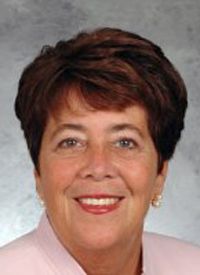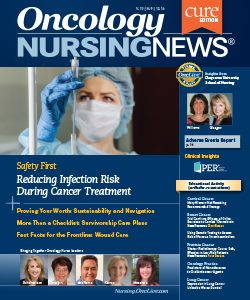The Power of Patient-Centered Care in Preventing Infections
Venous access devices can come with major problems, such as catheter-related infections, thrombosis and loss of function.
Anne Llewellyn, RN-BC, MS, BHSA, CCM, CRRN

Anne Llewellyn, RN-BC, MS, BHSA, CCM, CRRN
Vascular access is an important component to improving quality of life for patients with cancer. Access is required not only for chemotherapy, but also for frequent blood sampling and intravenous supportive measures. Vascular access devices provide reliable venous access, protect peripheral access, and increase patient comfort through reducing repeated and difficult venipuncture.
Today, numerous devices are available for this purpose and selection is dependent upon type and duration of access, patient factors, and physician preference. These include implantable devices, tunneled catheters, and peripherally inserted central catheter (PICC) lines.
Venous access is not without complication. Although insertion and placement problems are rare with modern access and imaging techniques, catheter-related infection, thrombosis, and loss of function continue to be major problems. In order to combat complications, best practices are emerging.
As a nurse for over 40 years in the Emergency Department and Respiratory Intensive Care, I am familiar with the important role venous access devices play in caring for patients who have serious medical conditions as well as the complications that can occur.
Venous Access Device Team Made All the Difference
When I was diagnosed with a central nervous system lymphoma in 2014, I knew that I was really sick when my hematologist told me I would need to have a PICC line placed so I could get chemotherapy because the tumor was inoperable.
Looking back, I realize I am alive today due to the aggressive treatment protocol prescribed by the hematology team, but also because of the excellent nursing care I received that protected me from infection and the other complications that I was at risk for as a result of my condition. During the early part of my treatment, I was not aware of what was happening to me. My husband was my advocate as I was confused and could not comprehend things.
As I became more alert, I was able to observe what was happening to me as a patient on the oncology floor of the Sylvester Comprehensive Cancer Center at the University of Miami. One thing that stood out for me was the care that I received from the oncology nurses who worked on the inpatient unit as well in the outpatient settings where I was treated.
Wendy A. Nunez, RN

Wendy A. Nunez, RN
The systematic processes were very apparent to me, especially in how my PICC line was changed. I had not seen this before, and I was curious to know how such a large team of nurses working across so many settings could work so well together. One of the nurses who came to see me daily to examine and redress my PICC line was open to answering.
Wendy A. Nunez, RN, is a member of the center’s Venous Access Device Nurses. On one of her visits, I asked her what the nurses on her team do and what they look for when working with patients who had central lines.
“We want to know if the patient and the caregivers understand what is needed to care for and maintain a central line,” Nunez explained. “It's important that every patient understands what to look out for to prevent infection. Also, we want to be sure the patient knows when a dressing needs to be changed, and what to expect from the nurses who are caring for the line.”
Importantly, all of the nurses who were involved in my care (inpatient and outpatient) used the same technique when they changed my PICC line. “The Venous Access Team works closely with the education department to be sure that all nurses are practicing according to our policy and procedures as well as standards of practice,” Nunez noted. “We are strict with following these policies because the oncology population is vulnerable to infections.”
Educating Patients About Caring for Their PICC Line
As I progressed in my treatment, I realized that I and my husband had an important role to play in my plan of care. One thing the nurses stressed who cared for me was how to care for the PICC line when we were home.
“The venous access team strongly believes that patient education is key,” stressed Nunez. “Patients who are knowledgeable in the care and maintenance of their line report problems sooner, protect their dressings more, and have less fear about the central line. Teaching the patient and caregiver reportable signs and symptoms and when to call the doctor cannot only save their line, but, more importantly, can save their life.”
“We let patients know it is important for everyone to perform hand hygiene before touching the central line,” she continued. “We teach how often the dressing should be changed, that the dressing change must be done using sterile technique, and everyone should wear a mask while the dressing is changed. We make sure the patient understands that the hub of the central line must be scrubbed appropriately between each injection and connection to the central line.”
In addition, the nurses explain that the dressing should always look pristine, clean, dry, and intact, and who to call if it is not. “It's important as nurses to arm the patient with knowledge about central lines in their fight against cancer. The central line is central to their treatment, so it's important for them to be well informed about it.”
I could see that the education Wendy’s team provided was working because regardless of where I was in the system, each person took their time, explained what they were going to do, and followed the same protocol. As a result, I felt safe and secure in their care. My husband, as the main caregiver, understood what he needed to do in order to care for the PICC line when we were home. He was given the resources to allow me to shower and the information he needed so he could pick up on a problem and who to call if a problem arose. This gave us both peace of mind.
As a nurse, I know that hospital-acquired infections are serious problems across our country. As I thought about what I was observing, I wanted to know if the training and standardization of processes throughout the University of Miami Healthcare System/Sylvester Comprehensive Cancer Center helped to decrease infection rates. Nunez shared that, “Yes, we did see a decrease in infection since the standardization on all of our inpatient units.”
I know it is a challenge to do system-wide training, so I asked Nunez how they accomplished this task: “The Venous Access Device Nurse Team worked closely with the education department to train incoming nurses. During orientation, we train them on the policies and procedures for central line care and maintenance. We make sure all nurses are on the same page when they are employed. We want nurses to be vigilant and aware regarding central line care and maintenance, as well as educating patients to care for their line.”
As a patient, I am grateful to all of the professionals who cared for me. I feel fortunate that I had a good outcome and continue to heal. As a nurse, I know that complications can occur, but with the focus on education and instituting a culture of vigilance and caring, positive outcomes do occur. Today, it is being recognized more and more that the challenges we face in the healthcare system will not change until we ensure the patient and the caregivers are recognized as members of the care team.
Additional Resources
Association for Professionals in Infection Control and Epidemiology (APIC)
APIC Implementation Guide to Preventing Central Line—Associated Bloodstream Infections
National Institute for Health and Care Excellence (NICE)
Infection: Prevention and Control of Healthcare-Associated Infections in Primary and Community Care: Partial Update of NICE Clinical Guideline 2
Anne Llewellyn, RN-BC, MS, BHSA, CCM, CRRN, is a healthcare leader with over 40 years of experience as a critical care nurse, case manager, professional patient advocate, educator, digital journalist, and most recently as a patient with cancer, having been diagnosed and successfully treated for a central nervous system brain tumor. She is involved in a number of educational projects in the state of Florida and nationally. To contact Anne, send an email to allewellyn5@bellsouth.net.

Shared Model of Care Post-HCT Offers Safe Follow-Up, Reduces Patient Burden
Published: March 19th 2025 | Updated: March 19th 2025Alternating post-HCT care between specialized facilities and local cancer centers produced noninferior non-relapse mortality and similar quality of life to usual care.


